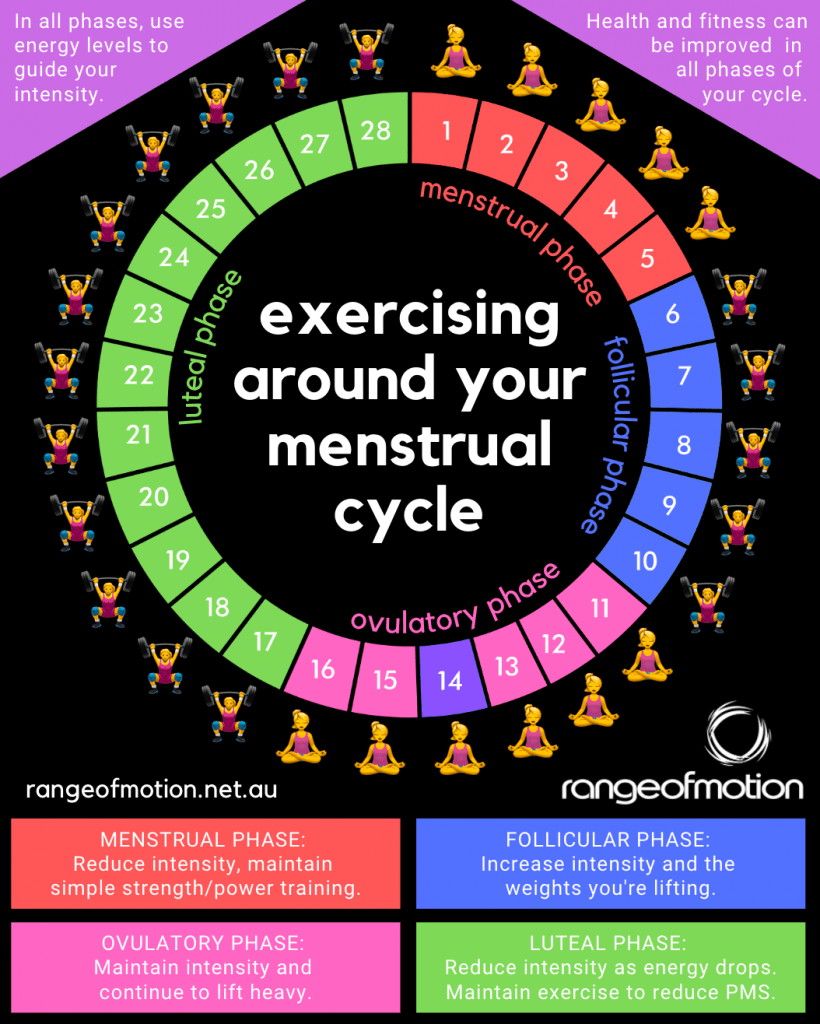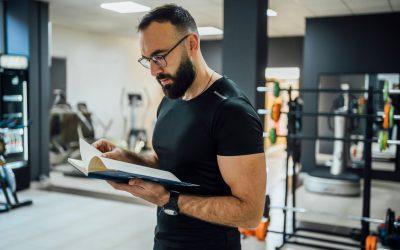Have you considered how your menstrual cycle impacts exercise? Or how exercise impacts your menstrual cycle?
You should.
Different forms of exercise are best suited to different stages of your cycle.
In this article, we will teach you how to match up your stage with your exercise to maximise your health and fitness.

Menstrual Phase (days 1 to 7 of your cycle).
The first phase of your cycle coincides with the beginning of your period. While this is often an uncomfortable time, the right kinds of exercise can be beneficial.
At this point, your cortisol levels are higher. Cortisol, a stress hormone, can be increased by exercise (and any other forms of stress on the body), so it’s a good idea to reduce the intensity of your exercise and the length of sessions to keep the cortisol in check.
Reductions in iron levels due to blood loss may also contribute to the fatigue you’re feeling.
Simple strength training and reduced intensity aerobic exercise works well. Strength loss is common during the menstrual phase, so continuing strength training (even if it’s at a lower intensity) can help to maintain strength.
Speed and power training can be included here as well, but keep the coordination requirements low, and skill and precision are impaired during this stage.
This is also a great time to prioritise your pre- and post- exercise routines. With less time spent doing vigorous exercise, reallocate some of your time to helping your body recover and correcting any little imbalances and technique faults. Increases in inflammation during this phase also make recovery extra important.
It’s also a great time to prioritise forms of exercise that make you feel good. A lot of women (and men for that matter) find more rhythmical movements (like walking, jogging, cycling or rowing) to be great for mental health. Taking your exercise outside can also be restorative.
Your metabolism will be highest during this phase, so even though you’re exercising less, your body will continue to expend energy to stay alive.
Towards the end of the menstrual phase you will begin to feel your energy return. Listen to your body, and when this happens, you can begin to ramp up the intensity.
Styles of training to prioritise:
- Continuous Cardiovascular
- Multi-Modal (slight intensity reduction)
- Olympic Lifting (drills)
- Power (slight intensity reduction)
- Relative Stamina (slight intensity reduction)
- Relative Strength (slight intensity reduction)
- Absolute Strength (slight intensity reduction)
Styles of training to reduce the intensity on:
- Heavy Loaded Conditioning
- Moderate Loaded Conditioning
- Energy System Intervals (high intensity intervals)
Follicular Phase (days 8 to 13 of your cycle).
As you transition from the menstrual phase to the follicular phase, your energy will begin to return. This signals an opportunity to return to heavier and higher intensity training.
You will also feel very high levels of motivation at this time – so make sure you capitalise on these!
The levels of cortisol (the stress hormone) have now dropped, so it’s more acceptable to now cause positive stress or ‘eustress’ to your body, to cause positive training effects. Estrogen will begin to increase as your body prepares for a potential pregnancy.
The styles of training we’re looking to prioritise here are heavy lifting and higher intensity cardiorespiratory training. This is when you’re at your strongest, so if you’re going for a new one rep max – this is the place to do it. Along with increases in intensity, you can increase volume, as your body is better able to recover.
This is the time when the highest levels of training stimulus can be applied to the body. Not only will the body handle the stress, but it will adapt well to the demands you’re placing on it. This is your time to get strong.
It is particularly important to increase intensity during this phase as your metabolism will drop. Higher volume and intensity will help to counteract the effects of a lower metabolism. Your body’s insulin sensitivity will also increase, which can help your body better use blood glucose to provide energy.
One thing to take note of however is the importance of adequately preparing the body for training. Injury rates can be higher in the follicular phases. Estrogen can impact tendon and ligament laxity in the lead up to ovulation. To combat this, ensure a pre- and post- exercise routine that is specific to that day’s training.
Styles of training to prioritise:
- Heavy Loaded Conditioning
- Moderate Loaded Conditioning
- Energy System Intervals (high intensity intervals)
- Multi-Modal
- Continuous Cardiovascular
- Relative Stamina
- Olympic Lifting (drills)
- Power
- Absolute Strength
- Relative Strength
Ovulatory Phase (days 14 to 21 of your cycle).
As you enter the ovulatory phases, a lot of the training recommendations from the follicular phase still apply.
Heavy loads and high intensity continue to be well accepted by the body, and the body’s response to exercise remains high. Higher progesterone levels mean that your body will not build strength as effectively as you would in the follicular phase, but strength training should still be a priority. Protein intake becomes even more important than normal.
The ovulatory phase provides a great opportunity to prioritise your higher intensity endurance training.
One unique element of this phase however, is the increase in body temperature you may experience. Be aware of exercising in warmer weather, and increase your hydration levels.
Higher levels of progesterone may also mean you need to add in a little more recovery work.
Styles of training to prioritise:
- Heavy Loaded Conditioning
- Moderate Loaded Conditioning
- Energy System Intervals (high intensity intervals)
- Multi-Modal
- Continuous Cardiovascular
- Relative Stamina
- Olympic Lifting (drills)
- Power
- Absolute Strength
- Relative Strength
Luteal Phase (days 22 to 28 of your cycle).
Immediately after ovulation the luteal phase begins.
At the beginning of this phase, your energy levels will remain high as your experience the residual effects of the hormones of the ovulatory phase.
While energy is high, load and intensity can remain high.
As this stage progresses (and you get closer to your period) however, you will likely experience a reduction in energy levels. This will require a reduction in exercise intensity and load. The focus should be on maintaining the physical capacities you have developed over the last two phases.
Towards the end of the luteal phase, you may begin to experience pre- menstrual syndrome. This is a signal to taper off the intensity as testosterone and estrogen drop off and inflammation increases..
It’s important to not stop exercise completely however. Aerobic exercise can help to balance levels of estrogen and progesterone to reduce symptoms of PMS.
As with our recommendations in the menstrual phase, prioritise exercise types that make you feel good physically, mentally and emotionally. You should also prioritise sleep and healthy eating (as you should in every stage, but particularly now).
Styles of training to prioritise:
- Continuous Cardiovascular
- Multi-Modal (slight intensity reduction)
- Olympic Lifting (drills)
- Power (slight intensity reduction)
- Relative Stamina (slight intensity reduction)
- Relative Strength (slight intensity reduction)
- Absolute Strength (slight intensity reduction)
Styles of training to reduce the intensity on:
- Heavy Loaded Conditioning
- Moderate Loaded Conditioning
- Energy System Intervals (high intensity intervals)
There are some key takeaways from these recommendations.
It’s a cliche, but listen to your body. The times when you feel most energetic, are the times when you can lift heavy and exercise with intensity.
Even though we’ve recommended certain types of exercise in certain stages, you can do any form of exercise in any stage. Just modify the intensity to match how you’re feeling.
You can continue to improve your health and fitness no matter where you are in your cycle. The different stages aren’t a reason to avoid certain types of exercise but a guide to how to maximise your health.





